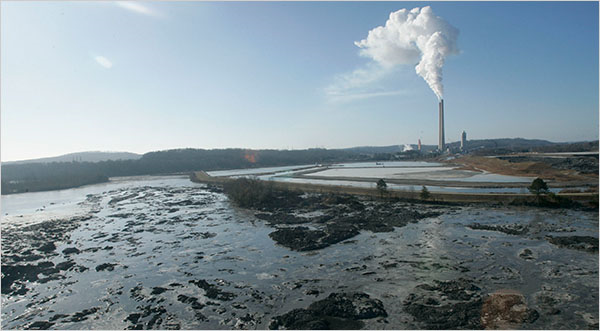Hundreds of US coal ash dumps lack regulation
By SHAILA DEWAN
6 January 2009 The coal ash pond that ruptured and sent a billion gallons of toxic sludge across 300 acres of East Tennessee in December 2008 was only one of more than 1,300 similar dumps across the United States — most of them unregulated and unmonitored — that contain billions more gallons of fly ash and other byproducts of burning coal. Like the one in Tennessee, most of these dumps, which reach up to 1,500 acres, contain heavy metals like arsenic, lead, mercury and selenium, which are considered by the Environmental Protection Agency to be a threat to water supplies and human health. Yet they are not subject to any federal regulation, which experts say could have prevented the spill, and there is little monitoring of their effects on the surrounding environment. In fact, coal ash is used throughout the country for construction fill, mine reclamation and other “beneficial uses.” In 2007, according to a coal industry estimate, 50 tons of fly ash even went to agricultural uses, like improving soil’s ability to hold water, despite a 1999 E.P.A. warning about high levels of arsenic. The industry has promoted the reuse of coal combustion products because of the growing amount of them being produced each year — 131 million tons in 2007, up from less than 90 million tons in 1990. The amount of coal ash has ballooned in part because of increased demand for electricity, but more because air pollution controls have improved. Contaminants and waste products that once spewed through the coal plants’ smokestacks are increasingly captured in the form of solid waste, held in huge piles in 46 states, near cities like Pittsburgh, St. Louis and Tampa, Fla., and on the shores of Lake Erie, Lake Michigan and the Mississippi River.
Numerous studies have shown that the ash can leach toxic substances that can cause cancer, birth defects and other health problems in humans, and can decimate fish, bird and frog populations in and around ash dumps, causing developmental problems like tadpoles born without teeth, or fish with severe spinal deformities. “Your household garbage is managed much more consistently” than coal combustion waste, said Dr. Thomas A. Burke, an epidemiologist at the Johns Hopkins Bloomberg School of Public Health, who testified on the health effects of coal ash before a Congressional subcommittee last year. “It’s such a large volume of waste, and it’s so essential to the country’s energy supply; it’s basically been a loophole in the country’s waste management strategy.” As the E.P.A. has studied whether to regulate coal ash waste, the cases of drinking wells and surface water contaminated by leaching from the dumps or the use of the ash has swelled. In 2007, an E.P.A. report identified 63 sites in 26 states where the water was contaminated by heavy metals from such dumps, including three other Tennessee Valley Authority dumps. Environmental advocacy groups have submitted at least 17 additional cases that they say should be added to that list. …

